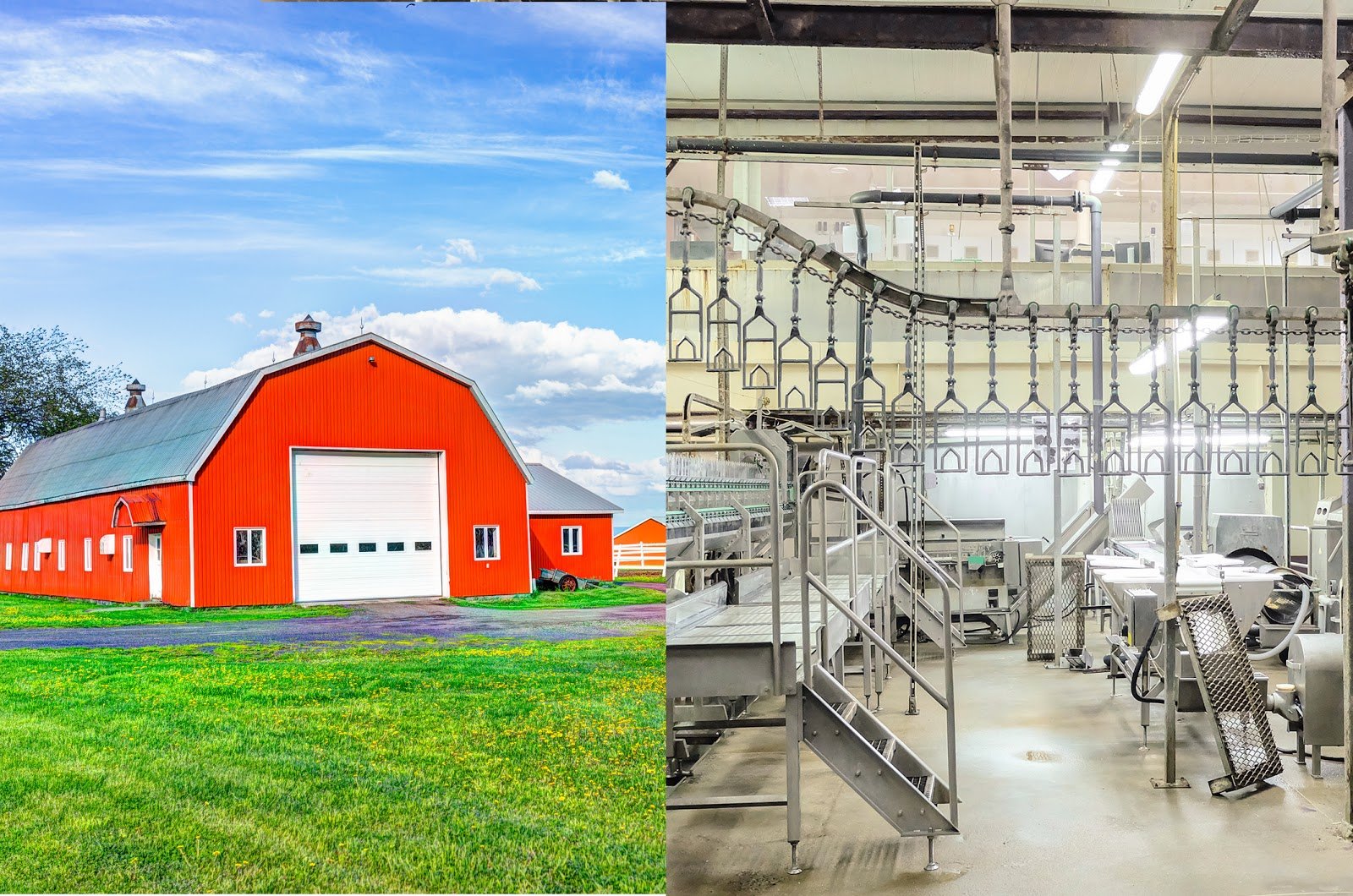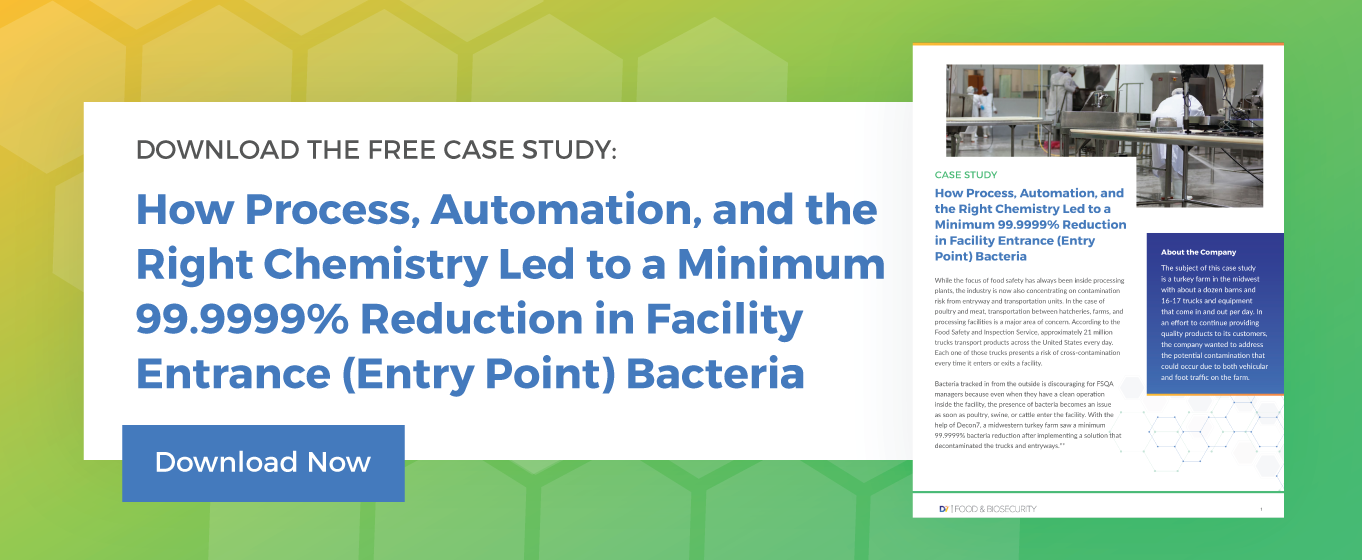
At food processing facilities across the country, cross-contamination prevention, reducing labor, and cutting chemical costs are of the utmost importance. No matter how extensive its sanitation protocols are, what happens outside the facility can still have serious consequences inside the facility. Foodborne pathogens can be present at farms and hatcheries, in storage areas, in the vehicles that transport food, and on all of the people that interact with products throughout the chain. Any time an individual or vehicle enters a facility that has been sanitized, the risk of cross-contamination exists unless the proper precautions have been taken.
Thinking beyond the facility is critical when addressing food safety and biosecurity issues. Fortunately, professionals in the food industry have realized this and are starting to pay more attention to contamination risk from entryways and transportation units.
- Decon7 offers the patented anti-microbial chemical D7 for cleaning, sanitizing, and disinfecting.
- D7’s foam adhesion allows for a full contact time and was developed and formulated to be efficacious against a wide variety of organisms*.
- D7 is used in a wide variety of industries, including food, biosecurity, vehicle wash, public safety, and first responders.
- D7 is EPA registered to penetrate, kill and remove biofilms. Experience the D7 difference
*See EPA Master Label for full list of claims
How Pathogens Spread to and from Non-Food-Contact Areas
Not surprisingly, the primary focus of many FSQA managers is maintaining a sanitary environment in the areas where food is being handled. Food handlers who work in processing plants are familiar with the protocols designed to reduce the risk of cross-contamination while in the food-contact zone. However, the areas outside of this zone also provide opportunities for contamination, and it’s important for everybody in the processing chain to understand this.
Cross-Contamination Between Zones
A recent study titled An Agent‐Based Model for Pathogen Persistence and Cross‐Contamination Dynamics in a Food Facility showed that contamination can occur even in areas where people have no direct contact with food, including restrooms, offices, and loading docks. The study used computer modeling to show how Listeria can move between different areas depending on typical employee behaviors, such as:
- Touching food-contact surfaces and equipment
- Putting on and removing gloves
- Touching walls and floors in various zones
- Coming into contact with food packaging in loading areas
- Touching items in restrooms and offices
To account for the types of scenarios that arise in the real world, the study examined a range of factors, including the frequency of cleaning events, microbial growth rates, possible individual behaviors, entries and exits, and dynamic scheduling. Multiple scenarios were analyzed to account for different levels of initial contamination in each zone. The results showed that when any one zone (including non-food-contact areas) was contaminated, pathogens were subsequently found in the other zones.
Importantly, bacteria persisted longer when they were introduced in the areas farthest away from the food-contact zones, presumably because these areas are sanitized less frequently and cross-contamination is allowed to continue for a longer period of time. The study also noted that the surfaces in non-food-contact areas are better able to harbor bacteria because, like many food-contact surfaces, they are not designed to be resistant to bacteria.
According to the study, the primary modes for transfer of bacteria were:
- Moving contaminated packaging from the loading dock to the food processing area and subsequent contact with objects such as the floor, non-food-contact surfaces, and the trash can
- On the hands and gloves of employees during food preparation activities between doorknobs and food-contact surfaces
- On employees’ shoes
While it is possible to change behaviors to a certain degree, the risk of contamination can also be reduced by sanitizing surfaces, including those outside of food-contact zones.
Cross-Contamination in Transportation
In addition to individual behaviors and the training and protocols designed to shape them, the equipment used to transport food cannot be ignored. According to the Food Safety and Inspection Service, approximately 21 million trucks transport products across the country every day. Each of those vehicles presents a risk of cross-contamination every time it enters a facility.
One report, Effect of the food production chain from farm practices to vegetable processing on outbreak incidence, cited several other research studies that linked food contamination to storage and transportation practices before the products reached the processing facility, including:
- Post-harvest contamination from hands to food or food-contact surfaces
- Stacking storage bins directly onto soil
- Cross-contamination during rapid cooling in refrigerated storage areas
- Employees walking between compost sites and production areas
- Carts moving between compost areas and production areas
- A lack of reporting to help track the source of outbreaks
- Improper use of sanitary hand-washing facilities
The study also notes the challenges associated with identifying the source of an outbreak when a product has moved through several points in the supply chain, especially when multiple vehicles are used for transportation between facilities.
FDA Recommendations
The Food and Drug Administration has provided the document, Guidance for Industry: Guide to Minimize Microbial Food Safety Hazards of Fresh-cut Fruits and Vegetables. In terms of transportation and entry/exit points, much of this guidance can also extend to other types of facilities, including:
- Adequately screening openings and drains to prevent pest entry
- Transporting products as soon as possible after harvest
- Inspecting delivery vehicles for cleanliness
- Retaining a record of all incoming ingredients and their sources
- Maintaining separation between raw ingredients and finished products
- Maintaining recommended refrigeration temperatures at each stage
- Using dedicated transportation containers and sanitizing them between uses
- Inspecting transportation containers for contamination before use
- Using self-closing mechanisms on entry and exit doors
- Creating maze-like entries and exits between zones
Of course, every facility will have unique hazards and solutions for avoiding them. However, these general recommendations are a good starting point when developing standard operating procedures for your facility.
Additionally, the FDA has provided Guidance for Industry: Sanitary Transportation of Food to help food processors reduce the risk of food contamination through transportation practices. In addition to employee hygiene, pest control, proper refrigeration, and facility and vehicle maintenance, the organization recommends the following practices:
- Sanitizing transportation vehicles and loading equipment
- Following sanitary procedures while loading and unloading products
- Maintaining records to track sanitation procedures
- Employee and driver training
Having clear policies, sanitation protocols, and standard operating procedures for employees to follow is critical during every stage of food processing, including the steps taken outside of processing plants. By being proactive and taking contamination issues head-on, food processing facilities can achieve the highest standards of cleanliness and compliance.
*Disclaimer: Review D7 product label before use


